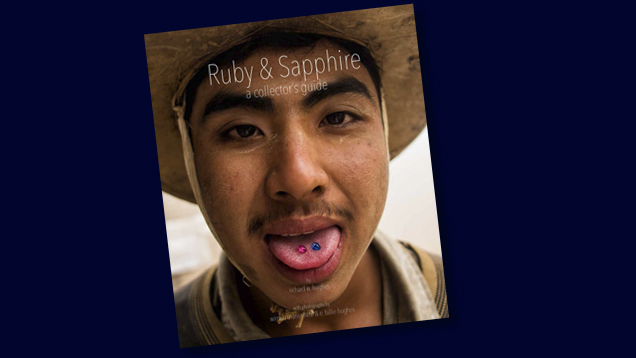Books: Ruby & Sapphire:
A Collector’s Guide

As Hughes notes in the foreword, his focus is on the relationship between people and gems, which he calls “humanistic gemology.” While many artisanal small-scale miners toil for years without success, he explains, some do strike it rich, instantly elevating them and their families into a new realm of existence. As Hughes points out, however, wealth does not always bring happiness and can often be fleeting. One of my favorite sidebars is the legend of Darky Garnet, who arrived in Rubyvale, Australia, with only a wheelbarrow full of worldly possessions. Garnet struck it rich, lived like a king, shared his wealth with friends and strangers, and left penniless with only his wheelbarrow and the shirt on his back. He is celebrated to this day with an annual tribute one must read to believe.
The first chapter features colorful illustrations and photos of ancient frescos, mines, and jewelry dating back hundreds and even thousands of years. Hughes suggests that Sri Lankan traders brought rubies and sapphires to Europe in early Greco-Roman times, making them the earliest stones of value tendered for international trade and commerce. Today, a gemstone’s value is defined by its beauty, rarity, durability, and transportability. This chapter continues with the varied and abundant history associated with the search for and fashioning of corundum. Ruby and sapphire were frequently mistaken for other gems such as spinel and lapis. It was not until the advancement of mineral science in the 17th and 18th centuries that these two members of the corundum family were fully understood. Another major obstacle in the understanding of gems relates to nomenclature, or “wordsmithing” as Hughes aptly puts it; these issues still exist in the trade today. Hughes states that until the early 19th century, the word “oriental” was used as a prefix to describe gems that could achieve a higher polish because of their superior hardness. Thus oriental topaz actually referred to yellow sapphire, while oriental amethyst referred to purple sapphire. In 1805 Rene Just Haüy formally combined these and other sapphires, along with ruby, into the group now known as corundum.
The chapter on source countries takes the reader on an incredible adventure to ruby- and sapphire-producing countries, providing a virtual tour of these fascinating locales. Hughes begins with a clear, concise explanation of the geologic forces that led to the conditions required for gemstone mineralization. Fascinating details are provided about the people, mining, and production in the major corundum sources: Southeast Asia, Central Asia, Australia, Africa, and North America.
Hughes then shares many secrets of the trade to help collectors make educated decisions. Details of what to look for in color, clarity, cut, and country of origin are clearly conveyed, but the reader is encouraged to always go with personal preference. In the case of ruby, the market tends to favor stones with a more intense color, but Hughes advises not to overlook those of slightly less saturation that might offer more brightness and versatility. A sidebar titled “Clarifying Clarity” provides delightful insight on how to judge a gem’s internal issues. He suggests that the budding collector “develop perspective” through research, visits to auctions and gem shows, and networking with jewelers and dealers. One of the most interesting excerpts features renowned mineral and gem dealer William Larson expounding on his vast connoisseurship of crystals. Larson shares how his passion for minerals, which began when he was just a boy, has grown into one of the finest private collections of specimens in the world. He offers his suggestions on building a meaningful collection.
One of my favorite sections examines left-brain objective pricing vs. right-brain subjective preference. A graph comparing recent auction results, coupled with gem photos, gives a colorful dimension to the author’s message. Understanding gem value is one of the most difficult things to master. Auction results, scattered throughout the book, provide the reader with tangible examples of some of the finest gems and jewelry sold over the past two decades, such as a 6.04 carat Burmese ruby which sold in 2013 for over US$3.3 million, and an 8.91 carat Kashmir sapphire which sold in 2012 for over US$1.3 million. He also includes wonderful sections on judging stars and cabochons, fancy-color sapphires, and suites.
Chapter four delves into the internal world of forensic gemology, balancing out the book’s earlier focus on people, places, emotion, and lore. Hughes explains the skills and instrumentation needed to identify synthetics, treatments, and country-of-origin characteristics. Well-deserved tribute is paid to the artistic skills and scientific knowledge required to properly capture, identify, and apply microscopic observations. The benefits and drawbacks of gem treatments are also clearly discussed.
Another valuable tool in the gemologist’s arsenal is a reference library. Chapter six gives direction on how to accumulate a useful and refined gemological library. As always, Hughes provides a generous and detailed bibliography, recommending numerous volumes and journals. In the final chapter, many of the amazing photos featured throughout the book are beautifully grouped to help communicate the subtle nuances that make up the diverse corundum family.
Throughout, Richard Hughes spices up the book with his colorful style, personal anecdotes, quotes, and fascinating sidebars. Every gemologist, dealer, connoisseur, collector, and gem enthusiast should own this indispensable work.
.jpg)


